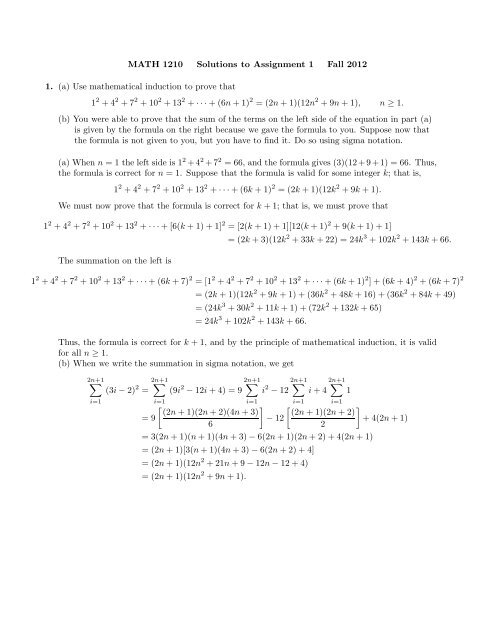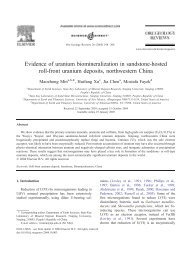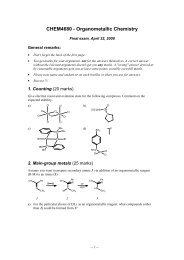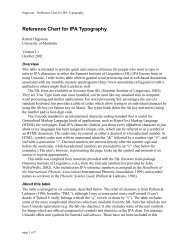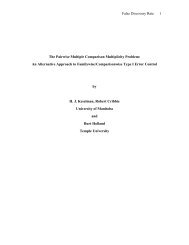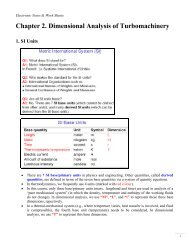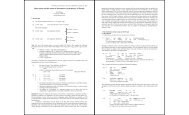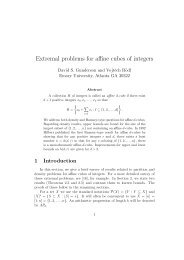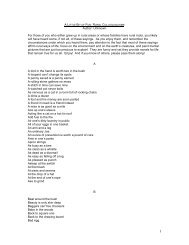MATH 1210 Solutions to Assignment 1 Fall 2012 1. (a) Use ...
MATH 1210 Solutions to Assignment 1 Fall 2012 1. (a) Use ...
MATH 1210 Solutions to Assignment 1 Fall 2012 1. (a) Use ...
You also want an ePaper? Increase the reach of your titles
YUMPU automatically turns print PDFs into web optimized ePapers that Google loves.
<strong>MATH</strong> <strong>1210</strong> <strong>Solutions</strong> <strong>to</strong> <strong>Assignment</strong> 1 <strong>Fall</strong> <strong>2012</strong><br />
<strong>1.</strong> (a) <strong>Use</strong> mathematical induction <strong>to</strong> prove that<br />
1 2 + 4 2 + 7 2 + 10 2 + 13 2 + · · · + (6n + 1) 2 = (2n + 1)(12n 2 + 9n + 1), n ≥ <strong>1.</strong><br />
(b) You were able <strong>to</strong> prove that the sum of the terms on the left side of the equation in part (a)<br />
is given by the formula on the right because we gave the formula <strong>to</strong> you. Suppose now that<br />
the formula is not given <strong>to</strong> you, but you have <strong>to</strong> find it. Do so using sigma notation.<br />
(a) When n = 1 the left side is 1 2 +4 2 +7 2 = 66, and the formula gives (3)(12+9+1) = 66. Thus,<br />
the formula is correct for n = <strong>1.</strong> Suppose that the formula is valid for some integer k; that is,<br />
1 2 + 4 2 + 7 2 + 10 2 + 13 2 + · · · + (6k + 1) 2 = (2k + 1)(12k 2 + 9k + 1).<br />
We must now prove that the formula is correct for k + 1; that is, we must prove that<br />
1 2 + 4 2 + 7 2 + 10 2 + 13 2 + · · · + [6(k + 1) + 1] 2 = [2(k + 1) + 1][12(k + 1) 2 + 9(k + 1) + 1]<br />
The summation on the left is<br />
= (2k + 3)(12k 2 + 33k + 22) = 24k 3 + 102k 2 + 143k + 66.<br />
1 2 + 4 2 + 7 2 + 10 2 + 13 2 + · · · + (6k + 7) 2 = [1 2 + 4 2 + 7 2 + 10 2 + 13 2 + · · · + (6k + 1) 2 ] + (6k + 4) 2 + (6k + 7) 2<br />
= (2k + 1)(12k 2 + 9k + 1) + (36k 2 + 48k + 16) + (36k 2 + 84k + 49)<br />
= (24k 3 + 30k 2 + 11k + 1) + (72k 2 + 132k + 65)<br />
= 24k 3 + 102k 2 + 143k + 66.<br />
Thus, the formula is correct for k + 1, and by the principle of mathematical induction, it is valid<br />
for all n ≥ <strong>1.</strong><br />
(b) When we write the summation in sigma notation, we get<br />
2n+1 �<br />
i=1<br />
(3i − 2) 2 =<br />
2n+1 �<br />
i=1<br />
(9i 2 2n+1 �<br />
− 12i + 4) = 9<br />
i=1<br />
i 2 2n+1 �<br />
− 12<br />
i=1<br />
2n+1 �<br />
i + 4<br />
� � � �<br />
(2n + 1)(2n + 2)(4n + 3) (2n + 1)(2n + 2)<br />
= 9<br />
− 12<br />
+ 4(2n + 1)<br />
6<br />
2<br />
= 3(2n + 1)(n + 1)(4n + 3) − 6(2n + 1)(2n + 2) + 4(2n + 1)<br />
= (2n + 1)[3(n + 1)(4n + 3) − 6(2n + 2) + 4]<br />
= (2n + 1)(12n 2 + 21n + 9 − 12n − 12 + 4)<br />
= (2n + 1)(12n 2 + 9n + 1).<br />
i=1<br />
1
2. Prove that 3 n + 7 n − 2 is divisible by 8 for all n ≥ <strong>1.</strong><br />
When n = 1, 3 n + 7 n − 2 = 8, which is divisible by 8. The result is therefore valid for n = <strong>1.</strong><br />
Suppose that 3 k + 7 k − 2 is divisible by 8. We must now show that 3 k+1 + 7 k+1 − 2 is divisible by<br />
8. We write that<br />
3 k+1 + 7 k+1 − 2 = 3 · 3 k + 7 · 7 k − 2 = 3(3 k + 7 k − 2) − 3 · 7 k + 6 + 7 · 7 k − 2<br />
= 3(3 k + 7 k − 2) + 4 · 7 k + 4 = 3(3 k + 7 k − 2) + 4(7 k + 1).<br />
Now 3 k + 7 k − 2 is divisible by 8. Furthermore, 7 n + 1 is always an even integer, and is therefore<br />
divisible by 2. Hence, 4(7 k + 1) is divisible by 8. It follows that the right side of the equation is<br />
divisible by 8, and therefore so also must be 3 k+1 + 7 k+1 − 2. The result is valid for k + 1, and by<br />
the principle of mathematical induction, it is valid for all n ≥ <strong>1.</strong><br />
3. (a) <strong>Use</strong> mathematical induction <strong>to</strong> prove that n 2 > 2n + 1 for all n ≥ 3.<br />
(b) <strong>Use</strong> the result in part (a) <strong>to</strong> prove that 2 n > n 2 for n ≥ 5.<br />
(a) Certainly 3 2 > 2(3)+1, so that the result is true for n = 3. Suppose that k 2 > 2k +1 for some<br />
integer k. We must now show that (k + 1) 2 > 2(k + 1) + 1 = 2k + 3. Now,<br />
(k + 1) 2 = k 2 + 2k + 1 > (2k + 1) + 2k + 1 = 4k + 2 = (2k + 3) + (2k − 1) > 2k + 3.<br />
Thus, the result is valid for k + 1, and is therefore correct for all n ≥ 3 (by the principle of<br />
mathematical induction).<br />
(b) Certainly, 2 5 > 5 2 , so that the inequality is valid for n = 5. Suppose that 2 k > k 2 for some<br />
integer k. We must show that 2 k+1 > (k + 1) 2 . Now,<br />
2 k+1 = 2 · 2 k > 2(k 2 ) = 2k 2 = k 2 + k 2<br />
> k 2 + 2k + 1 (by part (a))<br />
= (k + 1) 2 .<br />
Consequently, the inequality is correct for k + 1, and by the principle of mathematical induction,<br />
it is valid for all n ≥ 5.
4. Find a formula for<br />
Hint: See Exercise 34 in Section <strong>1.</strong>2.<br />
We write that<br />
1<br />
4i 2 − 1 =<br />
n�<br />
i=1<br />
1<br />
4i 2 − 1 .<br />
� �<br />
1 1/2 1/2 1 1 1<br />
= − = − .<br />
(2i + 1)(2i − 1) 2i − 1 2i + 1 2 2i − 1 2i + 1<br />
With this, we can write terms in the sum in the following form<br />
n� 1<br />
4i<br />
i=1<br />
2 n�<br />
� �<br />
1 1 1<br />
= −<br />
− 1 2 2i − 1 2i + 1<br />
i=1<br />
= 1<br />
��<br />
1 −<br />
2<br />
1<br />
� � � � � � ��<br />
1 1 1 1 1 1<br />
+ − + − + · · · + − .<br />
3 3 5 5 7 2n − 1 2n + 1<br />
Most terms cancel and what remains is<br />
n� 1<br />
4i2 �<br />
1<br />
= 1 −<br />
− 1 2<br />
1<br />
�<br />
=<br />
2n + 1<br />
n<br />
2n + 1 .<br />
5. Evaluate<br />
i=1<br />
n�<br />
(2j − 1) 2<br />
j=m<br />
for n > m. It is not necessary for you <strong>to</strong> simplify your result.<br />
n�<br />
(2j − 1) 2 =<br />
j=m<br />
=<br />
= 4<br />
n�<br />
(2j − 1) 2 −<br />
j=1<br />
m−1 �<br />
j=1<br />
n�<br />
(4j2 − 4j + 1) −<br />
j=1<br />
n�<br />
j 2 − 4<br />
j=1<br />
n�<br />
j +<br />
j=1<br />
(2j − 1) 2<br />
m−1 �<br />
j=1<br />
n�<br />
j=1<br />
(4j 2 − 4j + 1)<br />
m−1 �<br />
1 − 4 j 2 m−1 �<br />
+ 4<br />
j=1<br />
� � � �<br />
n(n + 1)(2n + 1) n(n + 1)<br />
= 4<br />
− 4 + n<br />
6<br />
2<br />
� � � �<br />
(m − 1)(m)(2m − 1) (m − 1)(m)<br />
− 4<br />
+ 4<br />
− (m − 1).<br />
6<br />
2<br />
j=1<br />
j −<br />
m−1 �<br />
j=1<br />
1
6. Simplify each of the following complex expressions <strong>to</strong> Cartesian form:<br />
(a) i15 (3 + 2i) 2<br />
1 − i<br />
= (−i)(5 + 12i)<br />
(b) i6 (1 + 2i)(3 − 4i)<br />
3 + 2i<br />
(a)<br />
1 − i<br />
= (−1)(1 − 2i)(3 + 4i)<br />
i 15 (3 + 2i) 2<br />
1 − i<br />
= (12 − 5i)(1 + i)<br />
(1 − i)(1 + i)<br />
3 − 2i<br />
7. Find all solutions for each of the following equations:<br />
(a) Using the quadratic formula,<br />
(b) If we set w = z 2 , then<br />
<strong>Solutions</strong> of this equation are<br />
Thus,<br />
= (−11 + 2i)(3 + 2i)<br />
(b)<br />
= 17 + 7i<br />
2<br />
i 6 (1 + 2i)(3 − 4i)<br />
3 + 2i<br />
= 17<br />
2<br />
(3 − 2i)(3 + 2i)<br />
+ 7<br />
2 i<br />
= −37 − 16i<br />
13<br />
(a) 2z 2 + 3z + 15 = 0 (b) z 4 + 3z 2 − 5 = 0<br />
z = −3 ± √ 9 − 120<br />
4<br />
z2 = −3 + √ 29<br />
2<br />
When we take square roots,<br />
�<br />
−3 +<br />
z = ±<br />
√ 29<br />
2<br />
= −3 ± √ −111<br />
4<br />
w 2 + 3w − 5 = 0.<br />
w = −3 ± √ 9 + 20<br />
2<br />
= −3 ± √ 29<br />
.<br />
2<br />
= −3 ± √ 111i<br />
.<br />
4<br />
or z2 = −3 − √ 29<br />
.<br />
2<br />
or z = ±<br />
�<br />
3 + √ 29<br />
i.<br />
2<br />
= − 37 16<br />
−<br />
13 13 i


